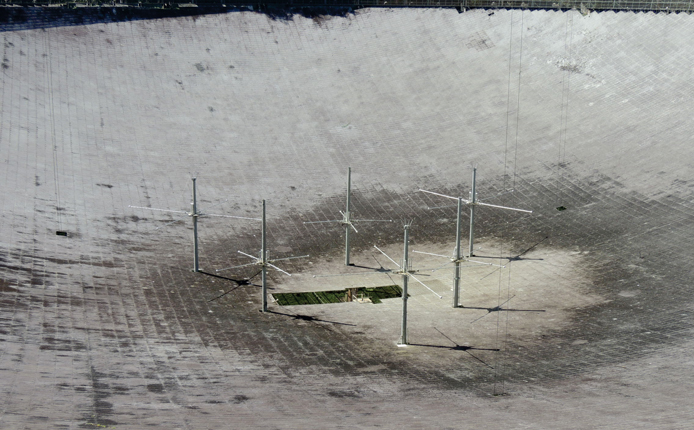Atmospheric research heats up at Arecibo
DOI: 10.1063/PT.3.2341
For many geophysical and atmospheric observations, scientists lie in wait for storms and other naturally occurring phenomena. But high-frequency (HF) ionospheric heaters, like the one set to start up this spring at the Arecibo Observatory in Puerto Rico, can turn the ionosphere into a plasma-physics laboratory.
The HF heater is used to deposit energy into the ionosphere in a controlled way; scientists observe the response to learn about the ionosphere and neutral upper atmosphere. For example, heating a bit of plasma and then watching how it cools takes about 15 minutes, says Sixto González, Arecibo’s director for space and atmospheric sciences. The process mimics what happens in the ionosphere during sunrise, “so I could heat and let cool, over and over. That’s 30 or 40 sunrises in a night,” says González. He did such studies with Arecibo’s last HF heater, which was wiped out in 1998 by Hurricane Georges.
To protect them from gale winds, the six dipole antennas on the new HF heater fold up like umbrellas against their tower mounts. In the new design, the towers poke through specially made holes (about 1 m by 2 m) in the Arecibo telescope’s primary reflector (see photo). The signals—three of the antennas are tuned to transmit at 5.1 MHz and the other three at 8.175 MHz—go up, to be reflected from a large wire mesh back down to the dish, and then out to space.

JAIME GAGO, ARECIBO OBSERVATORY/SRI INTERNATIONAL

The large amount of power needed—100 kW per antenna—is a limiting factor, González notes. Running the HF heater “consumes more than 200 pounds of diesel per hour, so we probably cannot afford to use it more than 120 or 150 hours a year.” The observatory has already received 20 proposals requesting more than 500 hours, he says. Among the topics the new facility will look into are electron acceleration processes, ionospheric structure irregularities at meter to subkilometer scales, electron thermal balance, and resonant ion oscillations.
Other ionospheric heaters put out more power than Arecibo’s (see the story on page 22
The $2.5 million Arecibo heater was paid for by the Air Force Research Laboratory and the Office of Naval Research ($500 000 each) and NSF ($1.1 million), with the rest from the observatory’s annual budget. The transmitters and their power supplies, heat exchangers, and power lines were free—they were US Air Force surplus originally from a Cold War–era long-range surveillance system that watched for aerial approaches to the US.
In recent years, the Arecibo Observatory budget, paid by NSF and NASA, has shrunk by more than a third. But the half-century-old facility still boasts the largest dish in the world and continues to contribute to science (see the article by Daniel Altschuler and Chris Salter in Physics Today, November 2013, page 43
More about the Authors
Toni Feder. tfeder@aip.org
